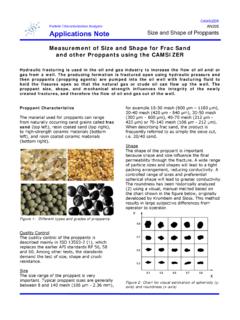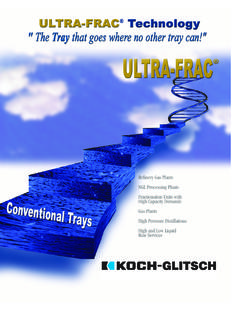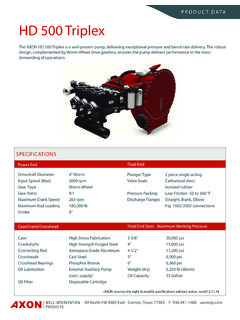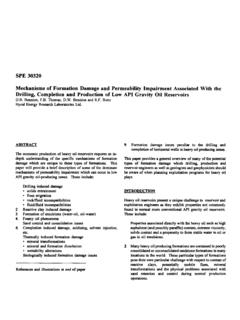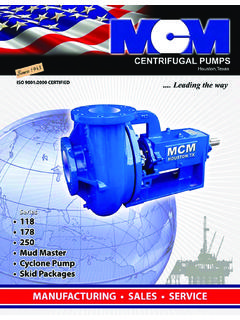Transcription of TEG Contactor for Gas Dehydration J.P. Nivargi, …
1 TEG Contactor for Gas Dehydration Nivargi, Gupta, S. J. Shaikh, Shah 1. Introduction Water vapor is the most common undesirable impurity in gas streams. Usually, water vapor and hydrate formation, solid phase that may precipitate from the gas when it is compressed or cooled. Liquid water accelerates corrosion and ice (or solid hydrates) can plug valves, fittings, and even gas lines. To prevent such difficulties, essentially gas stream, which is to be transported in transmission lines, must be dehydrated as per pipeline specifications.
2 The processing of natural gas to the pipeline specifications usually involves four main processes; Oil and condensate removal Water removal Separation of natural gas liquids Sulfur and carbon dioxide removal Most of the liquid free water associated with extracted natural gas is removed by simple separation methods at or near the wellhead. However, the removal of the water vapor requires more complex treatment, which usually involves one of the two process, either absorption or adsorption. In absorption, dehydrating agent ( glycols) is employed to remove water vapors and in adsorption, solid desiccants like alumina, silica gel, and molecular sieves can be used.
3 The absorption process has gain wide acceptance because of proven technology and simplicity in design and operation. 2. Glycol Dehydration Glycols are extremely stable to thermal and chemical decomposition, readily available at moderate cost, useful for continuous operation and are easy to regenerate. These properties make glycols as obvious choice as dehydrating agents. In the liquid state, water molecules are highly associated because of hydrogen bonding. The hydroxyl and ether groups in glycols form similar associations with water molecules.
4 This liquid phase hydrogen bonding with glycols provides higher affinity for absorption of water in glycol. Four glycols have been successfully used to dry natural gas: ethylene glycol (EG), Diethylene glycol (DEG), Triethylene glycol (TEG) and Tetraethylene glycol (TREG). TEG has gained universal acceptance as the most cost effective choice because: TEG is more easily regenerated to a concentration of in an atmospheric stripper because of its high boiling point and decomposition temperature. Vaporization temperature losses are lower than EG or DEG Capital and operating cost are lower Diethylene glycol is preferred for applications below about 10oC because of the high viscosity of TEG in this temperature range.
5 3. Process Description As shown in Figure 1, wet natural gas is first flashed in an inlet separator to remove liquid and solid content. The gas stream from separator is dried in Contactor using counter current glycol stream with temperature difference of around 5 oC with that of gas stream. The dry gas passes through a gas/ glycol heat exchangers to cool lean glycol. The rich glycol, from the bottom of the Contactor , is flashed at reduced pressure in flash tank where dissolved hydrocarbon gases are recovered and further it is preheated with lean glycol in a glycol/ glycol heat exchanger.
6 After exchanging heat, the rich glycol is further fed to the stripping column where TEG gets concentrated only upto Further purity in stripper is not recommended due to limitation of maximum reboiler temperature of about 204oC. Higher temperature in reboiler can lead to undesirable process of decomposition of glycol. The purity of (wt) is achieved in a regeneration column where TEG is stripped by using some part of dried gas, processed in Contactor . The regenerated TEG is recycled back to the Contactor . 4. contactors Contactor is most important mass transfer equipment in TEG Dehydration since its performance has crucial impact on downstream processes.
7 The typical Contactor is provided with internals like Vane Inlet Device (VID) for gas distribution, Chimney tray for collection of liquid, trays/packings for mass transfer and demister to minimize TEG losses. Mass transfer in Contactor can be achieved by using Bubble cap, Valve trays, Sieve trays or Structured packings. In earlier days, bubble cap trays were commonly used in Contactor . But in recent decade, due to proven performance of the structured packing, TEG contactors are now designed or revamped with high capacity structured packing.
8 Typical Contactor for structured packing with all required internals is shown in Figure 2. TEGINSATGASTEGOUTDRYGASREGENOUTWATLEANTE GDRYFLVAPDGREGREGENBOTDRYGAS1 GASINLIQUIDTEGRECYCONTACTSTRIPPERPRREDRE GENFSPLITSPLITTERFLASHPUMPCOOLEREXCHNGER TEGDRYGASATEGREC1 GLY/GASGLY/GLY Figure 1: Flow diagram for TEG Dehydration 5. Hardware required for Contactor Vane Inlet Device (VID) VID is commonly used for introducing gas/liquid mixtures into the column . It mainly consists of series flat blades which evenly distribute inlet gas. The purpose of VID is to reduce momentum of the feed.
9 Performs separation of solids and liquid,if any, from the gas . achieve an even gas distribution across the column cross section by splitting the feed mixture into a series of flat jets. The inlet device allows for considerable reductions of the vessel height and inlet nozzle size. Packing Support Packing Support is use to support structured packing and allow easy passage for gas and liquid traffic. FinepacTM INT-SP-01 is open flat grid type packing support plate designed for use with structured packing in columns lesser than 900 mm internal diameter.
10 The minimum width of the support ring is 60mm. The standard design has grid bars spaced on 75mm centres but variations with closer grid spacings. FinepacTM INT-SP-02 is open flat grid type Packing Support Plate designed for use with structured packing in columns larger than 900mm internal diameter. The plate is made up in 375mm wide segmental sections which can be installed through column manways (minimum manway size 450mm NB) and bolted together inside the column. The standard design has grid bars spaced on 75mm centres but variations with closer grid spacings can be manufactured to support packings where the support plate capacity is not full annular support ring needs to be welded to the wall of the column to hold the support plate.
